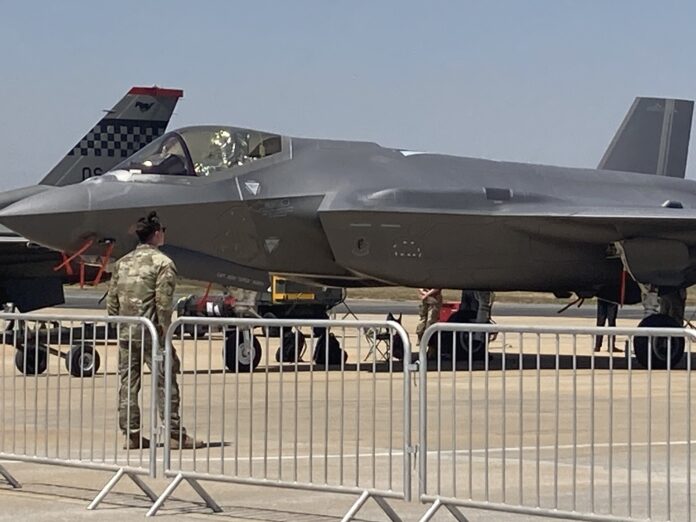BENGALURU— In the balmy skies over Yelahanka Air Force Station, the spectacle of Aero India 2025 is going to commence on February 10, with precision aerobatics, thunderous flybys, and a showcase of cutting-edge technology. Yet beneath the thrilling choreographed displays and gleaming fighter jets lies a deeper narrative, that of a geopolitical chessboard where India asserts its growing influence in the global defence sector. With the sheer scale of the event and preparations, the number of participants and the grandeur of Aero India 2023, India’s defence industry has obviously announced its coming to the world stage.
This year, Aero India 2025, has drawn more than 700 exhibitors, including industry heavyweights from the United States, Europe, and Asia, underscoring India’s emergence as a significant player in the defence and aerospace markets. Beyond the razzmatazz of air displays, the event is a forum for strategic dialogue, business deals, and subtle power plays, reflecting the nation’s ambitions to become a manufacturing and defence export powerhouse.
A Platform for Atmanirbharta
Since the launch of the “Make in India” initiative in 2014, the Modi government has sought to transform India into a hub for advanced manufacturing. Aero India 2025 is a microcosm of this vision, featuring indigenously developed equipment such as the Light Combat Aircraft (LCA) Tejas, the Hindustan Turbo Trainer-40, and the Advanced Light Helicopter. These exhibits are not merely technological marvels; they symbolise India’s aspiration to achieve atmanirbharta (self-reliance) and increase defence exports in a market estimated at over $500 billion.
Prime Minister Narendra Modi, in his inaugural address at Aero India 2023, reinforced this ambition. “India is no longer content being a buyer,” he declared. “We are emerging as a manufacturer, exporter, and trusted partner in global defence collaboration.”
Geopolitical Undercurrents
The presence of the United States, with its showcase of the F-35 stealth fighter and B-1B Lancer bombers, underscores a strategic pivot. The US is keen to deepen defence ties with India, positioning itself as a counterbalance to China’s growing assertiveness in the Indo-Pacific. The timing is particularly significant, coming amid heightened tensions between Washington and Beijing over issues ranging from trade to Taiwan.
For India, the F-35’s appearance is a diplomatic tightrope. While New Delhi remains committed to developing its Advanced Medium Combat Aircraft (AMCA), a fifth-generation stealth jet, the display of the F-35 signals the potential for deeper cooperation—or, at the very least, serves as a nudge from Washington to reduce dependence on Russian military hardware.
A Tug-of-War with Moscow
Russia, traditionally India’s largest defence supplier, is not ceding ground without a fight. Despite a subdued presence at Aero India 2025 due to ongoing sanctions and supply chain constraints, Moscow continues to court New Delhi. Reports suggest that Russia has invited India to join its Checkmate fighter jet project, a move aimed at bolstering the Su-75 programme and reinforcing long-standing defence ties.
Yet, the geopolitical landscape is shifting. Western nations, led by the US, view India’s partnership with Russia as a barrier to deeper alignment with the West, particularly in the context of the Ukraine war. Washington’s strategy is clear: lure India with advanced technology and joint ventures to reduce its reliance on Moscow while simultaneously enhancing its own strategic position in Asia and no better platform to show off than Aero India.
Beyond Defence Deals
The implications of Aero India extend beyond hardware sales. The event also serves as a platform to integrate Indian startups and micro, small, and medium enterprises (MSMEs) into the global supply chain. From drone technology to artificial intelligence, Indian firms are showcasing innovations that could redefine the future of warfare.
“Aero India is no longer just an air show,” says Defence Minister Rajnath Singh. “It’s a meeting ground where technology meets strategy, and partnerships shape the future.”
The Broader Geopolitical Signal
As F-16s roar across the Bengaluru skies, the symbolism is impossible to miss. Aero India is not merely a showcase of firepower; it is a statement of India’s growing geopolitical clout. The event signals India’s intent to navigate an increasingly multipolar world, balancing its traditional ties with Russia while forging deeper connections with the West.
For the United States, the presence of the F-35 represents more than a sales pitch—it’s a strategic declaration. As tensions with China simmer, Washington’s display of solidarity with New Delhi underscores the growing importance of the Indo-US partnership in shaping the future of the Indo-Pacific.
The Road Ahead
As Aero India 2025 approaches, it looks to leave behind more than just awe-inspiring memories for aviation enthusiasts. It cements India’s position as a rising defence manufacturing hub and a key player on the global geopolitical stage. The event underscores the delicate dance of alliances, rivalries, and ambitions that define the modern world.
In an era where airshows have become platforms for diplomacy, Aero India stands tall—not just as a celebration of technological prowess but as a testament to India’s vision of shaping its destiny in the skies and beyond.



